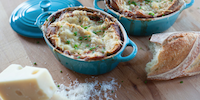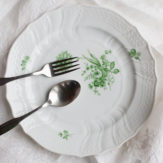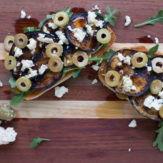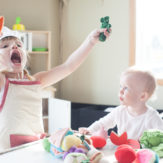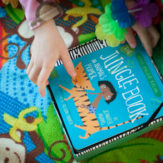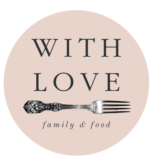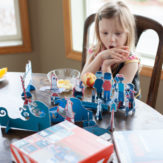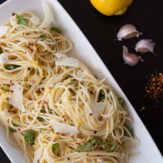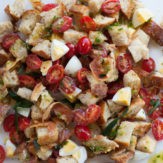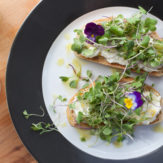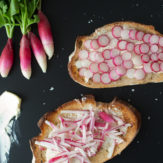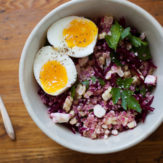.jpg)
When we were on our trip to Europe this summer, I read French Kids Eat Everything by Karen Le Billon. It was eye opening for me because, although we encouraged Gigi to eat and try “our food” we were missing the main point! “Our food” is also her food! I felt that we were asking something extraordinary of her to eat exactly what we were eating and we’d often follow up an offer of “our food” with something more “kid friendly”. She’s always been low in weight so we were concerned that she wasn’t eating enough and would always whip up something (after dinner) in order to ensure she got enough.
Before reading this book Gigi’s typical day was filled with scrambled eggs, quite a few snacks, milk, a tiny lunch, some of our dinner food (most of which ended up on the floor) or a customized toddler dinner (most of which ended up on the floor). We didn’t often eat together. Most of the time we gave Gigi dinner earlier in the evening and then we ate after she was in bed.
After reading French Kids Eat Everything I was a total convert to the idea that kids eat what adults eat. Period. I read, re-read, took notes and came home from our trip with a plan to change our ways. We’ve now been eating the “French” way for five months so I feel confident in sharing our experience with you. The rules are simple and following them has made a huge difference in the way we all eat.
The French Kids Eat Everything Rules
…and my thoughts on applying them at home…
1. Parents are in charge of children’s food education.
I simply talk to Gigi a lot more about food, she cooks with me more. We bought her these veggies, fruits and fish sets from Ikea and she cooks in her little kitchen. We ask her to make us dishes using specific toy food. She’s only two but as she gets older these conversations and games will change. We’ve started to talk about color, texture, and flavor as well.
2. Avoid emotional eating. Food is not a toy, a distraction, a bribe, a pacifier, a reward, or a substitute for discipline.
This rule brought on a wave of mom-guilt. Before reading this book I constantly used food as a toy, distraction and pacifier. Fussing in the car? Here’s some crackers in a snack catcher. Bored on a walk? Here’s a squeezy pack of baby food. When I realized that I was teaching Gigi that “food is the answer” to boredom, crankiness, etc. I felt really guilty. What kind of food habits was I setting her up with? We ditched the squeezy packs which are now in the emergency bin in the car for emergency only or reserved for long trips, and the snack catcher is now a bath toy.
3. Parents schedule meals and menus. Kids eat what adults eat: no substitutes and no short-order cooking.
This took surprisingly little adjustment on Gigi’s part! Since she wasn’t snacking she was really hungry when it came to be dinner time. The first day on the program she refused dinner and went to bed hungry. It sounds harsh but it was actually fairly smooth. She didn’t complain, she just didn’t want what was offered so we ate, read her a book and put her in bed. (She ate an enormous breakfast the following morning). Now things run smoothly. She’s used to being served what we are eating. She gets to make some choices at breakfast between a couple options we offer her… daily requests for waffles and cereal are not honored.
4. Food is social. Eat family meals together at the table, with no distractions.
We set the table every night for dinner, sit down together, say what we are grateful for, and then we eat. We have Gigi help us set the table. She picks out her place mat, plate, fork/knife/spoon, and cup and puts them on the table. Some evenings she’s more excited about helping than others but she usually eagerly participates. We always ask her to use the appropriate utensils while eating. She struggles with successfully using the utensils with every dish and usually uses them and her hands, but she’s learning. We never answer our phones (in fact they’re not allowed near the table), we try to include Gigi in our conversations and engage her by asking her questions. We ask her to eat like an adult! Family dinners are truly the best part of my day.
5. Eat a variety of food. Eat vegetables of all colors of the rainbow, don’t eat the same dish more than once per week.
We try to introduce lots of different foods to Gigi. We often eat the same dish more than once per week because we have leftovers. Cooking something new every night isn’t financially feasible for us. I am working on adding more veggies to the roundup.
6. You don’t have to like it but you have to taste it / eat it.
Using the word “taste” instead of “try” seems to work really well with Gigi. I feel like when I encourage her to “taste” something, I’m asking her to be adventurous and curious. The word “try” feels like I’m asking her to judge it, to decide if she likes it or not. We always put a bit of everything on her plate. If she refuses a food or tastes it and says, “I don’t want that!” We remind her that the polite thing to say is “no thank you” then we say, “That’s okay. We’ll taste it again another time”. Then we take it away or encourage her to leave it on her plate and assure her that she doesn’t have to eat it.
7. Limit snacks to one per day and not within one hour of meals. In between meals, it’s okay to feel hungry. At meals, eat until you’re satisfied, rather than full.
This was challenging when i was in the first trimester of pregnancy and we often shared a bagel and cream cheese on the couch (off schedule) but we’re back on track now. I actually have grown to love snack time. Since the idea is to give something high carbohydrate to give a boost of energy and tide kids over until dinner, I feel like I don’t have to be totally “responsible” at snack time. We often have things like cinnamon sugar toast, cookies and milk, a little trail-mix spiked with M&M’s, along with other snacks like apples and cheese, ants on a log, etc. It’s fun to get to throw something together for her or surprise her with a mid-day cookie. A typical French snack for kids is a bit of baguette with butter and melted chocolate! I was finding at times the Gigi didn’t seem totally hungry at dinner time so we cut back the quantity at snack time, we try to keep to about six bites. She’ll have half a piece of buttered toast, a few bites of yogurt and a couple slices of apple. I try to avoid protein at snack time.
8. Take your time, both for cooking and eating. Slow food is happy food.
This rule is easy for us. If you’ve been following this blog, you know that I love to cook. I rarely ever buy processed/pre-made food, and we rarely eat out. This means that all of our meals are made from scratch at home. Gigi is getting to the age where she loves to cook with me. She helps, asks questions, sometimes very much gets in the way… and I love it all.
9. Eat mostly real, homemade food, and save treats for special occasions. Avoid processed foods.
As I mentioned above, I make everything at home. And (again with the exception of the first trimester of pregnancy) I rarely buy any processed foods.
10. Eating is joyful, not stressful. Relax and enjoy the process of planning, preparing and feeding yourself and your family.
This rule is important to remember. Sometimes the planning and grocery shopping aspect can be a bit stressful and feels like it takes an entire day but, I love taking Gigi to the grocery store. I love interacting with the people there. I love planning our meals. Feeding my family is such a huge part of our days, weeks, months… why not embrace and enjoy it?
A few other things…
I don’t try to “hide” foods from Gigi. I don’t mix spinach in her brownies or add purées to things without telling her. I always tell her exactly what’s in her food. I don’t personally understand the point or idea of getting her to eat more vegetables if she isn’t going to eat them or learn to love them in their natural form. I don’t think there’s anything wrong with adding veggies to her food but I always tell her. On the same note we talk about what’s for dinner every night. We’ll show her that there’s mushrooms, spinach, ricotta, onion, etc. in her lasagna. I trust that she will learn to like them and I want her to recognize what she’s eating/tasting/liking. On the same note, we also let her eat anything and everything we eat. If we’re having chocolate we give her some. Sweets and candy are part of the food world too. If we eat it in moderation, I believe she will too. But I don’t think it’s fair to tell her she can’t have ice cream when we have it. If she has had too many sweets we’ll put her to bed and then have ice cream but we always share with her if she’s participating in a family event or meal.
In the book French Kids Eat Everything the author, Karen, talks a lot about how important it is for kids to learn to wait patiently. That’s part of the reason we all wait until we are seated and have said what we are grateful for. Last night we were all starving (dinner was a bit late) and I said to her, “Wait, what are you grateful for.”, and she looked right at me and said, “No Mama. I can’t.”, and started eating! Actually I was right there with her! But most of the time it’s a great opportunity to ask a small bit of patience from her… occasionally she even stops us from taking the first bite by saying, “WAIT! I grateful…..” These little “grateful” moments have become some of my favorite Gigi quotes. The other night she said, “I grateful…. maybe…. PENIS!!!” Ha. She’s learning about anatomy. The point is, I find that she’s been getting more and more patient as a result of these little moments. I find that I can say, “You can have this when we get home.”, or “We can do/have/read/see that in a little bit.” I think it’s a lot about building trust. She knows that I will follow through with it
We don’t battle over food. She rarely asks for snacks now that she’s used to the schedule. If she does I just say, “We’ll have a snack at snack time!” I avoid using the word “no” but I make it clear that it’s not snack time/we can’t have cookies for breakfast, etc. If she doesn’t want to eat something, that’s fine. There’s no use in battling. I would rather that we talk about it than have her hiding her peas in her napkin, and I will never tell her she can’t leave the table until she’s finished her cauliflower. That’s not fun for anyone! I won’t force her to eat a certain food. I want her to enjoy the process of learning about and exploring different foods. I feel that the power is in what I put on the table, rather than what I make her eat. After years of nannying I’ve learned that finding creative ways of avoiding a power struggle with a toddler is a major skill. At the table it’s particularly important.
Incorporating variety is challenging. We eat a lot of vegetables and fruits, but it’s not always easy to introduce new foods. Sometimes it’s downright defeating! But it does come around and work eventually. For example, some foods that Gigi refused and now loves: potatoes, onions, roasted garlic… it takes time but is really rewarding when she finally embraces something new. It seems that once she’s accepted something, potatoes for example, she’ll eat in all forms when we tell her what it is.
We try to eat all our meals together. At first, I was planning and making breakfast and lunches but we weren’t really eating them together regularly. But, over time we saw that Gigi was acting out a bit at those meals. Dropping food on the floor. Spilling her water on purpose. So we determined that having someone sit with her and eat with her would be a good thing, for all of us! Kyle and I both usually skip breakfast, or I would find that I wanted carbohydrates around 10am because I didn’t eat something healthier in the morning (I’m blaming pregnancy for part of this). Now we usually sit down together and have a big bowl of fruit and yogurt or eggs and whole grain toast. The social eating aspect of the French approach really does make a big difference. Now she eats at all meals and is getting better at telling us when she’s all done (as opposed to “showing” us by smearing food on the table).
There is enormous freedom in a schedule and routine. Because we are on a set schedule and the habits have now become engrained, I feel a huge sense of freedom with our meals. We can have a picnic on the floor, be lazy and give her a big plate of pasta, eat popcorn on the couch in the middle of the day… occasionally. Then we can get right back to our better eating habits the next day. In the same way that we put so much energy and effort into creating good sleep habits, then we could keep her up until 10pm on the 4th of July without risking total overhaul of sleep patterns, we can ignore the food rules from time to time because we know that the foundation is there to return to. By no means are we perfect “method” followers… some days are an absolute mess and Gigi has snacks all day and cereal for dinner! Some days are just like that, but we always have good intentions and get back on track as soon as we can.
I’m so glad we’ve started early with Gigi. I wish we’d started even earlier but I’m happy that we’re eating this way now. I do think we got off on the wrong foot with baby food. We will be following the French method this next time around: introducing a different menu of foods early on, skipping rice cereal all together. Karen has a great write up about feeding babies the French way here. For those of you who mentioned getting your babies with few teeth to start eating solid foods, I would recommend reading Baby Led Weaning. I haven’t read it myself but it’s been recommended by a few friends and my sister has had great success with it. Her nine month old eats everything (seriously, everything). The concept is essentially no purées. I’m ordering a copy to read before our daughter is born!
The Main Differences in Our Eating Habits
The Schedule:
The eating schedule proposed and followed in French Kids Eat Everything is:
Breakfast in the morning
Lunch around 12:30pm
Snack around 4:30pm
Dinner between 7:00pm and 8:00pm
It took a while for us to get on this schedule as we transitioned Gigi from one to two naps (she used to nap through lunchtime). Now our daily schedule looks like this:
7:30 breakfast
12:00 lunch
3:30 small snack and 1/2 cup milk
6:00 dinner (bedtime is at 7:30pm)
Our schedule is a tiny bit earlier than the French one provided in the book. It works perfectly for us.
Lunch:
Gigi still eats a rather small lunch. I do feel that I could do better making her bigger/better lunches with more variety. This has been a hard habit for both of us to change. In France, lunch is the biggest meal of the day. Here, dinner is. So while I’m working on adding variety, I’m not totally concerned about the size of her mid-day meals. I’m not trying to make lunch the biggest meal because that’s not realistic given my husband’s work schedule and our calorie needs at the end of the day. Also since children aren’t fed big wonderful lunches at school I have a feeling our kids will come home from school needing a big dinner!
Dinner Menus:
One big difference between the French eating habits and ours is the dinner menu plans. The typical French dinner includes a vegetable entrée (starter), plat principal (main dish), salade/fromage (cheese), and dessert. If our dinner is veggie heavy (like veggie lasagna) than we don’t normally have another veggie before dinner. But If I’m introducing a new vegetable, or if the vegetable is likely to get ignored in favor of pasta, than I will serve it first. I also am sure not to give her too much pasta. We are trying to follow the rule that she has to at least try/taste everything on her plate before she can have more pasta. We ask that she eats three bites of everything before she can have more of something she’s finished (usually pasta or bread which almost always gets eaten first)! And then it’s only a few bites worth of the pasta. For example, I love making Penne with Butternut Squash, Goat Cheese and Prosciutto for dinner but when I serve it up for her I make sure to only give her a little pasta along with everything else. That way she’s “forced” to eat other things before she can have more pasta. In other words, we try to keep everything in balance. If she has a few bites of everything she can have a few more bites of pasts. Sometimes we don’t giver her any more pasta until her plate is (mostly) clean. I do this when I know it’s a dinner she loves. With the Butternut Squash pasta dish, I know that she has learned to love the squash, the goat cheese, the prosciutto, and she’s working on the basil and red onion. So, I know that there is plenty of food on her plate that she enjoys.
Dessert:
We don’t have dessert every night. But if Gigi has had a particularly great meal and tried everything on her plate, I’ll often cut up an apple for us all to share, or we will each get five or six chocolate chips. I don’t think of it as a reward and I don’t tell her that it’s because she ate everything. It’s simply because I think she earned it. She doesn’t get to the end of each meal and ask for a treat but when she does it’s a good opportunity to say: “Yes. We all tried everything and I think it would be fun to have _____.” or “No. We aren’t going to have dessert tonight because we didn’t try everything on our plate.” She seems to understand both answers. One thing to keep in mind too is that she has no idea or expectation about what dessert entails. The other night Gigi asked me, “We have a treat?” and I told her, “I got nothin’!”, and she got so excited and squealed, “OH BOY!” It was so sweet, I got up and found a little something. But it taught me that, she doesn’t know of care what’s for dessert… it’s just the idea of having earned something.
Social Aspects:
Since, in France, these rules of no snacking, of eating what adults eat, of scheduled eating are part of the social construct, it is easy to follow. Trying to follow them here isn’t always easy. Gigi is often offered candy or crackers at the store/at play-dates/just before dinner. I try to be selective about when I say no. Within an hour of a meal time? No. A graham cracker while we are at the store? Ok. I don’t offer her these items but when they are shared by/with a friend outside of our home, I try to just go with the flow unless it could truly spoil a meal. On another note, after converting to this method, I’m actually shocked by some of the snacking I see. Every day at the grocery store I see parents searching in their bags for snack catchers, breaking open boxes of crackers, milk boxes, string cheeses, etc. Everywhere we go Gigi is offered snack food: from the cookie counter at the grocery store to the local coffee shop, to the park. Snacking is such an accepted part of our culture. It can be challenging to go against the “snacking culture” but I know I am doing the right thing for Gigi’s short and long term eating habits.
Another tricky thing about the social aspect is when we are eating out with friends. It’s difficult to make Gigi stay at the table while other kids are running around before, during, and after dinner, to make her wait patiently for the food to arrive when other kids are drinking juice/snacking on crackers, to serve her bits of what we’re eating instead of ordering mac and cheese or chicken fingers… But, this is a place that we have made the choice to ask a lot of her. We require her to behave politely, eat healthfully, wait patiently, etc. It’s not always easy but I believe it’s very important for our family. To be clear, I’m not judging what other families do with their kids… I know what’s right for our family and I do my very best to stick to that even when it’s hard. On a side note, if we are at a friends house we generally follow that family’s rules. If the kids are allowed to get down and play while the adults finish eating then Gigi is allowed to get down and play as well. I will add that when we’re heading into a sure to be challenging situation we discuss it ahead of time. For example, as we headed to the in-laws for four nights for Christmas this year, we decided as a family to put the rules on hold. We knew everyone would be snacking and it wasn’t fair to ask Gigi not to particpate. When we arrived we told Kyle’s parents, “Ok, we decided you can just spoil her and give her treats and cookies and snacks this time.” They seemed to enjoy the break in rules as much as Gigi did. They are such wonderful listeners we weren’t too worried about things getting out of hand. They know that McDonald’s is on my “absolutely never, no way in hell” list but if my mother-in-law wants to spoil her granddaughter with home baked cookies… I’m willing to set my rules aside. Food is social, and it’s important for me to remember that there are memories and experiences Gigi should get to have with her friends/grandparents/other kids.
This has been and continues to be a process with ups and downs. We try to enjoy every little success and not get caught up with “failures”. I feel really proud that G has learned to eat and love squashes, cucumber, potatoes, zucchini, kale, carrots, radishes (and those are just the vegetables) and willingly tries everything from broccoli to eggplant. Sometimes they go in, get chewed a bit and come back out but we don’t say anything or make a big deal out of it… I think it’s a success that she’s trying it and I’m confident that things will make it to her stomach. She seems to be outgrowing her “sensitivity” to texture. I find it really helpful to talk about new foods, at the store, while being prepared, while being served. For example: At the store: “These radishes are pretty! What color are they?” While preparing: “This radish is white on the inside! Can you help me put it on our salad?” While eating: “What does it taste like? Is it crunchy like an apple? Maybe it’s a little spicy?” The more she’s in an exploratory state of mind the more she seems to eat! I still cannot get her to enjoy green peas on their own (it’s fine if they’re mixed into a dish)… tasting these usually means licking one… but I am confident we’ll get there eventually. But I don’t worry too much about it. I also feel comfortable that if she decides she really does not like green peas, then that’s her choice. She’s eating enough variety of vegetables that I don’t worry about it. She does have her own individual tastes, as we all do. We will all measure our little successes differently since our kids are all different. For me every time she tries, eats, enjoys, says “that’s tasty!” to a new food, I feel proud and I count that as a success. Sometimes I’m completely surprised by her willingness to eat things: kale salad, pine nuts, gorgonzola, salsa, salad with micro-greens, hot sauce! It’s really a fun process to watch.
So, there you have it! Our “American” experience with French Kids Eat Everything. In the coming weeks I’ll share how I plan our weekly/monthly menus. How I budget our menus. I’ll provide a blank printable PDF of our menu format and our grocery shopping template. I’ll be introducing a new features called My Sous Chef which will be all about cooking with Gigi!
Have you read the book? What’s your experience been? I’m curious to hear and would love to incorporate advice and ideas into our day to day eating habits. If you haven’t read it, I highly recommend this wonderful book!
*There is a difference between picky eaters and an oral-motor/sensory defensive eater. The latter is a child who needs intervention from an Occupations Therapist and Speech Language Pathologist.



.png)
